Opening back up: Vaccine access is key to the Pacific’s Covid-19 recovery
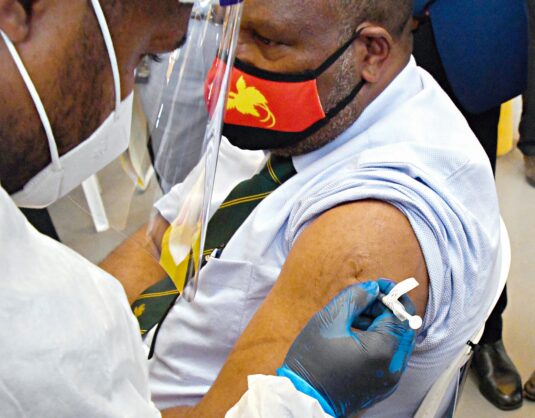
AFP
2021 is proving a more difficult pandemic year for the Pacific Island region than last year, emphasising the need for need more vaccines and long-term health infrastructure, Hugh McClure writes.
Australia’s vaccine diplomacy in the Pacific Island region reached a major milestone, with news that the country has now delivered one million vaccines.
Zed Seselja, Australia’s Minister for International Development and the Pacific, emphasised in a recent webinar that this was not the end of Canberra’s commitments, saying “we’ve committed 15 million doses for the Pacific going forward”.
Vaccines are desperately required in the Pacific. While the worst-case-scenario of rampant community transmission was avoided in 2020, 2021 has seen a dramatic deterioration in the Pacific’s fight against COVID-19.
Region-wide, cases have approximately doubled through the first half of 2021. Significantly, the geographical centre of these cases has shifted from the externally governed territories of French Polynesia and the United States territory of Guam, to Australia’s nearest neighbour, Papua New Guinea (PNG), and the tourist mecca of Fiji as Figures 1 and 2 show.
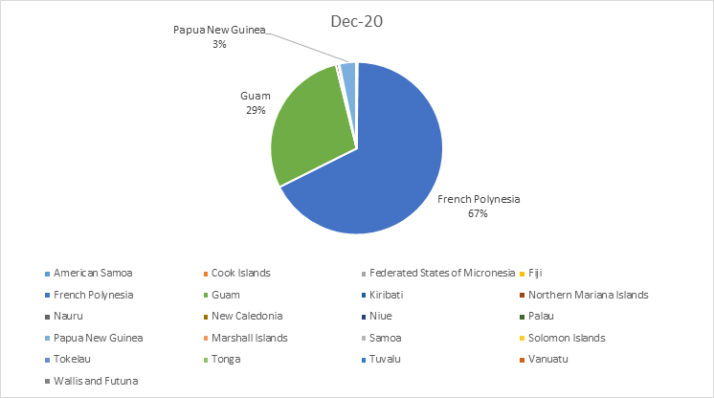
Figure 1
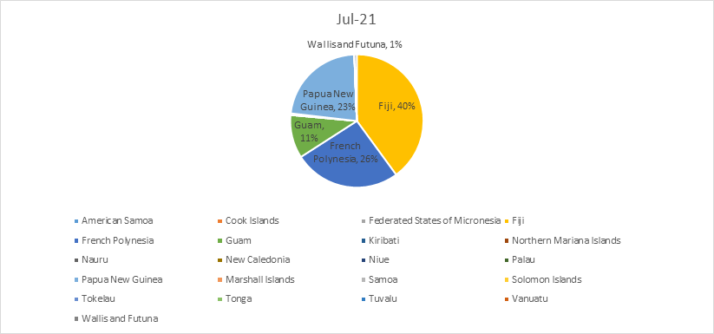
Figure 2
The delivery of one million doses is cause for celebration, but news out of the region remains sobering. While vaccines are being distributed to PNG and Fiji, they have not come quickly enough.
In PNG, positive cases rose from 900 at the start of February to 17,238 by June, with cases identified in every province, highlighting that the virus was circulating undetected throughout the country.
While the official figures are bad, low-testing rates mean that the true number of cases is likely many times greater than that which has been reported. Around a quarter of test samples returned positive results in some provinces during April.
The dire situation has highlighted chronic deficiencies in PNG’s health system and emphasised that long-term assistance should focus on building health infrastructure and capacity. This was perhaps best illustrated by reports of patients being treated on the floor at Port Moresby General Hospital due to a lack of capacity.
Similarly, COVID-19 outbreaks have also exposed serious weaknesses in Fiji’s health infrastructure and economy. Like several other Pacific Island nations, Fiji emerged largely unscathed from the first 12 months of the pandemic.
However, things quickly turned from good to catastrophic after one case of the Delta variant escaped border quarantine in April. Fiji now records among the highest rates of COVID-19 infection per capita in the world, surpassingformer hotspots such as India.
Fiji Prime Minister Frank Bainimarama has avoided calling a lockdown, stating that such a move would disproportionately hurt society’s most vulnerable, namely the tens of thousands who make ends meet by working in the informal economy. Despite this, the social and economic costs have been significant.
The region’s leaders, including Bainimarama, have said that vaccines, not lockdowns, will pave the path to normalcy. In time that might be true, but vaccination in a widely dispersed region, such as the Pacific, takes time, and many are suffering now. Like elsewhere, a multi-pronged approach is required, combining lockdowns, contact tracing, public education, and vaccines.
Analysis of vaccination rates across the Pacific reveals an uneven picture.
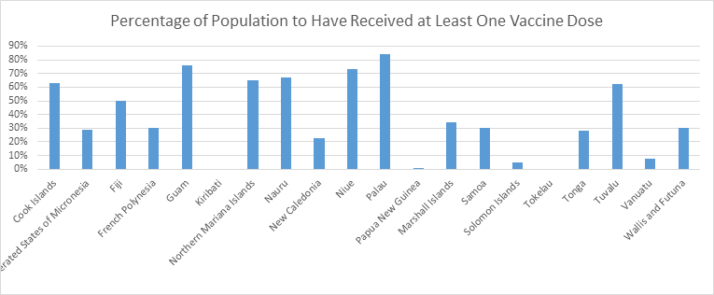
Figure 3
PNG reports the lowest vaccination rate in the world outside of Africa and Afghanistan. Millions more vaccines will be required to get the Pacific out of the grips of the pandemic.
COVID-19 Vaccines Global Access (COVAX) shipments have been slower than what was anticipated at the start of the year. For example, it was predicted in April that PNG would have more than 700,000 vaccines by the end of June – in reality, it received just 132,000.
Some parts of the Pacific have made impressive progress on vaccine rollout. The French Pacific territories, New Zealand’s ‘realm countries’, and the three Micronesian countries in the Compacts of Free Association with the United States have benefited from their relationships with the larger powers, such as through the US Operation Warp Speed program. While some of these territories accounted for the most cases in the region in 2020 due to their limited ability to independently close borders, their external relationships have led to impressive vaccine access.
The successful vaccination rollout in places like Palau, French Polynesia, and the Cook Islands is resulting in a faster rebound. Higher vaccination rates are not only leading to lower COVID-19 case numbers, but greater progress in re-opening the economy and forming travel bubbles.
With COVID-induced border closures creating large budget deficits, widespread unemployment, and other series social implications, an unequal vaccine rollout will have lasting implications for the region’s development. It’s a race to get vaccines to all in need.
Vaccine access inequality will delay the region’s economic recovery. In Samoa, authorities have said that borders won’t open until 98 per cent of the country has been vaccinated. Yet the country has only secured vaccines for 40,000 people in 2021 – enough for just a fraction of its 200,000 citizens.
Significantly, bilateral vaccine donations have been more efficient than those through COVAX. It has been vital for Pacific countries to leverage relationships with donors, including Australia, for vaccine access. As vaccine diplomacy has taken centre-stage, the United States, France, China, Japan, and New Zealand have all made commitments. Widespread vaccines, based on need, not politics, are required to lift the Pacific out of the pandemic, and re-start revenue streams.
With the end of the pandemic nowhere in sight, and the fragility of health systems in the region well acknowledged, there is still a long way to go before any ‘new normal’ emerges.
Until that time, Pacific islands will have to keep strengthening localisation and self-reliance, leverage global partnerships, and work to escalate the reach of public education, contact tracing, and vaccination programs. Tough times are still ahead, but there is much strength to be drawn from regional successes and growing assistance networks.
Hugh McClure
More Stories

Security Snapshot - 28 Mar 2024
Pacific Security Snapshot | 28 March 2024
Summary ➣ Heavy rains, floods, landslides and earthquakes batter the region ➣ Pacific submissions to the International Court of Justice (ICJ) on climate change responsibility ➣ Elections across the Pacific prompting changes to diplomatic relations and security arrangements ➣ Challenges for women in politics Climate Security Lives have been lost in PNG after a series…
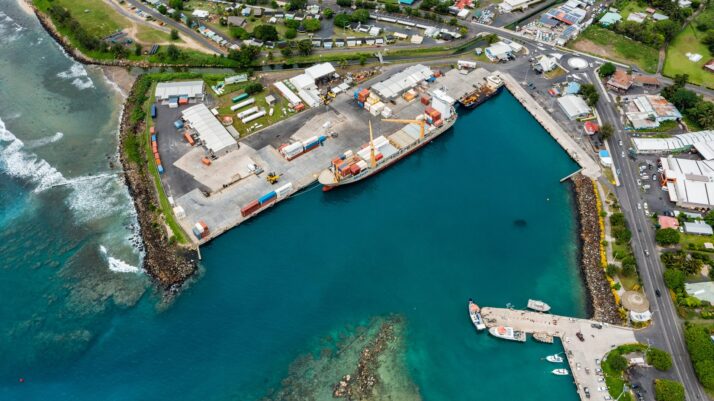
Blog - 25 Oct 2023
Australia must play a key role in the Pacific’s push to decarbonise shipping
There is an opportunity for Australia to work with Pacific islands to invest in new technology and take a leadership role in the decarbonisation of shipping in the region. Pacific leaders have stated their priority to transition to a fossil fuel free Pacific. Collectively they recently failed at getting the International Maritime Organisation (IMO) to…






